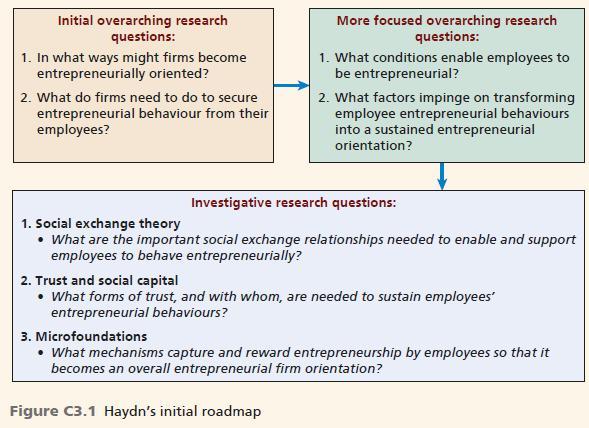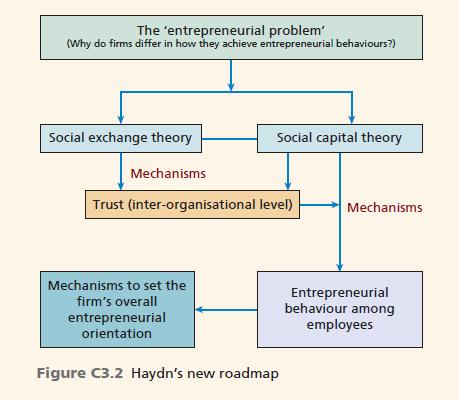Haydn is a postgraduate MSc Management and Entrepreneurship student and as part of his studies he needs
Question:
Haydn is a postgraduate MSc Management and Entrepreneurship student and as part of his studies he needs to complete a research project. Haydn has set his sights on studying a concept called 'entre- preneurial orientation' (EO) (Covin and Slevin 1989; Hughes and Morgan 2007; Hughes et al. 2020; Lumpkin and Dess 1996; Wales, Covin and Monsen 2020), and how a firm might achieve it. At the heart of this research pro- ject is a review of academic literature so that he can set out exactly what research gap and research question(s) his project will then attempt to answer. Haydn decided to conduct a systematic literature review to get a structured understand- ing of the field. He followed good practice to this effect. As part of his analysis, he classified research chronologically and thematically and drew several observations:
1 Chronologically, scholars had placed considerable emphasis on the performance effects of an entrepreneurial orientation, culminating in the Rauch et al. (2009) meta-analysis.
2 A generally positive relationship between EO and firm performance has been reported but studies continued to report some discrepancies. This led to a focus since 2010 on factors affecting how well EO drives firm performance.
3 Now, scholars are asking questions to do with how, when and why an EO becomes embed- ded in a firm or not and are beginning to look at the roles of individuals and teams.

Haydn is now at a crossroads. He treated the literature review as a synthesis and critique but now sees before him a wealth of research studies and lots of possible questions he could ask. Haydn feels paralysed and talks to his project tutor for advice. His project tutor tells him somewhat cryptically that 'not all questions are equal', and he challenges Haydn to consider what would be an 'interesting' question and what the differences may be between an initial research question and an overarching research question that was manageable. Haydn's project tutor also asked him to focus on a single area of interest. Haydn wondered why this was so. Haydn realised that there was little research answering the question, 'Why do firms differ in how they achieve entrepreneurial behaviours?' But he realised that this question was too big to be manageable. Looking at his literature review again, he decided to look beyond the struc- ture and themes in his systematic review and look for what was missing. It dawned on Haydn that for a firm to be entrepreneurial, its employees must exhibit and engage in entrepreneurial behaviour. Yet this problem was routinely overlooked. Discussing with his project tutor, the two crafted a roadmap (Figure C3.1) to move from the ‘entrepreneurial problem’ to where the answer might lie and what theories could be used along the way to help frame the research question.

Without realising it, the project tutor had helped Haydn not only to come to terms with the state of the art of EO research but also to scrutinise what is missing and help him to arrive at the real object of interest. Haydn was now engaged in critical evaluation and crafting both the research gap and the motivation for his work.
crafting both the research gap and the motivation for his work. His project tutor asked him to begin writing his actual research questions. This is no small feat. The challenge was how to define and then move from a more focused (and achievable) overarching research question to more detailed investigative questions. Haydn worked alone for several days to refine his roadmap and craft what he thought were investigative questions. He presented his work to his supervisor and his supervisor replied, 'You have sharper questions now, but they are still common-sense questions. To get to investigative research questions, you need to theoretically ground your ideas.' Together, Haydn and his supervisor set out a new roadmap (Figure C3.2):

Looking back, Haydn started to appreciate that his project tutor was teaching him the difference between reviewing the literature and setting out its structure, chronology and themes, to being able to craft his own contribution to the conversations taking place in the literature.
In doing so, Haydn realised that for his work to have meaning not just for himself and managers when he applies for future jobs, but also for those scholars for whom he was building his work, he needed to ask ‘good’ questions that had a clear pathway to be meaningfully answered.
Haydn now felt more confident that his ideas had merit. He could now see patterns and gaps in the literature and become excited about what he could offer in return. He had learned how to ask better questions so that his research would carry more weight and impact. He was able to use the literature he had read to craft both an overarching research question that was feasible and more detailed investigative questions. Crucially, he could justify why those questions mattered. Once Haydn had completed this process, he was confident that he had made informed decisions about the issues to include in his project and discuss in his literature review, and which issues he could confidently exclude.
Questions
1 List at least three things that any good literature review must do.
2 What might be the reasons for Haydn’s project tutor suggesting he focus on one area of interest, and not several?
3 What makes a piece of work interesting?
4 What actions described in the case can support Haydn’s claim to be undertaking an originalovel piece of research?
Step by Step Answer:

Research Methods For Business Students
ISBN: 9781292402727
9th Edition
Authors: Mark Saunders, Philip Lewis, Adrian Thornhill





